Recent Posts
Testing Physical Fitness:
The ways in which to test our physical fitness is limited only by our imagination. We could come up with all sorts of interesting and unique ways to test ourselves, but it's often best to stick with tests that have been in place and in practice for some amount of time.
Fitness exams which have withstood the test of time provide a good database of results to compare with, but best of all, the testing guidelines and procedures are already designed for easy following. There are two basic categories of fitness examinations - those that employ a physical activity and those that do not.
 Inactive Tests:
Inactive Tests:
There are ways with which to examine fitness without the use of any physical exertion. These tests provide a general feel for physical health and can be taken at any time.
Body Composition:
A measurement that gives the amount of body fat compared to lean tissues that an individual has. Higher levels of fat are regarded as less fit. This can be measured with the aid of skin fold calipers, hydrostatic weighing, electrolipography, body mass index, or bioelectrical impedance. The easiest method would be skin fold measurements, but the others would often be more accurate.
A screening can be administered by physicians that gives the total amount of cholesterol in the blood as well as the amount of HDL and LDL forms of cholesterol. While HDL is involved with removing cholesterol from the body and is desired, LDL is involved in the unwanted depositing of cholesterol in the body.
Proper HDL to LDL ratios are indicative of good exercise, weight management, and eating habits. Blood cholesterol levels are also directly related to the risk of coronary heart disease.
Heart Rate:

Can be measured most easily either by taking a pulse at the carotid artery on the neck or the radial artery on the wrist. Another way would be to use a heart rate monitor. Heart rates are most often taken at rest or during a physically intense activity, and they measure how hard the heart has to work to keep the body functioning under current conditions.
Unless someone is dead or dying, a lower heart rate at rest or even during activity typically indicates better fitness.
Testing Performance
Active Tests:
- Timed or Distance Runs - Evaluates cardiovascular ability.
- Sit-Ups - Assesses abdominal endurance through doing as many sit-ups as possible.
- Push-Ups - Evaluates upper body endurance through executing as many push-ups as possible.
- Chin-Ups - Measures arm and back endurance.
- Squats - Evaluates leg endurance.
- Vertical Jump - Evaluates strength and power.
- Long Jump - Measures leg strength performance during a standing jump.
- Bench Press - Evaluates upper body strength by determining maximum weight able to be pressed.
- Leg Press - Evaluates lower body strength through a one rep max.
- Grip Test - Measures one's hand and forearm strength.
Tests which measure the body's performance during an activity fall under this category. While general fitness is determined by the inactive tests, the more specific forms of fitness can be measured with examinations that monitor performance in specific physical tasks.
The details on how to execute many of the tests can be found at http://www.brianmac.demon.co.uk/eval.htm. The site also contains many more specific or comprehensive tests as well as normative data.
Stamina:
Strength:
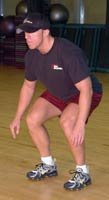

 Click Image To Enlarge.
Click Image To Enlarge.Vertical Jump.
Video Guides: Windows Media - MPEG - Video iPod

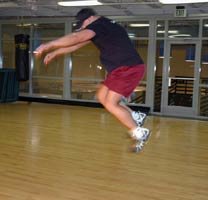
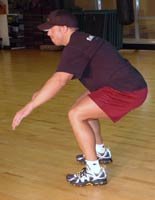
 Click Image To Enlarge.
Click Image To Enlarge.Long Jump.
Video Guides: Windows Media - MPEG - Video iPod
- Shuttle Run - Evaluates stamina and agility by sprinting back and forth between two markers.
- Illinois Agility Run - Evaluates agility over running a ten meter course with many directional changes.
Agility:
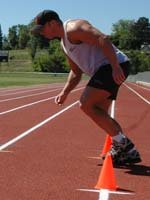
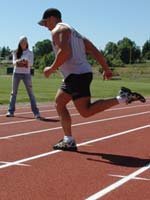
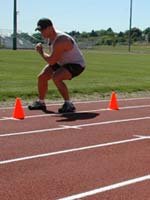
 Click Image To Enlarge.
Click Image To Enlarge.Shuttle Run.
Video Guide: Windows Media - MPEG - Video iPod
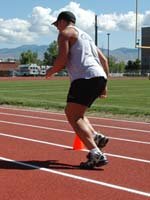
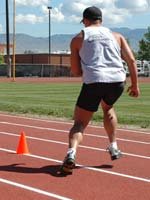
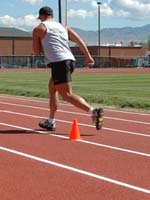
 Click Image To Enlarge.
Click Image To Enlarge.Illinois Agility Run.
Video Guide: Windows Media - MPEG - Video iPod
- Sit & Reach - Evaluates flexibility of trunk.
- Shoulder Rotation - Assesses flexibility of shoulders.
Flexibility:
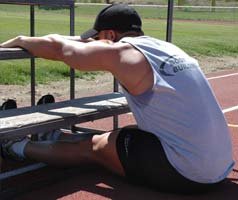
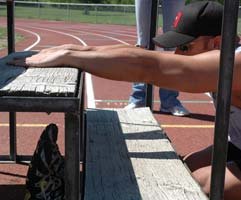
 Click Image To Enlarge.
Click Image To Enlarge.Sit & Reach.
Video Guide: Windows Media - MPEG - Video iPod



 Click Image To Enlarge.
Click Image To Enlarge.Shoulder Rotation.
Video Guide: Windows Media - MPEG - Video iPod
- Standing Stork Test - Evaluates overall static balance.
Balance:


 Click Image To Enlarge.
Click Image To Enlarge.Standing Stork Test.
Video Guide: Windows Media - MPEG - Video iPod
- Ruler Drop - Measures reaction time by measuring how quickly someone can catch a falling object.
Reactions:
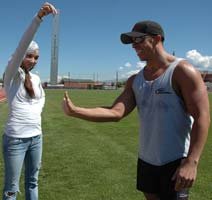
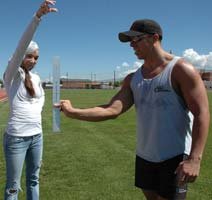
 Click Image To Enlarge.
Click Image To Enlarge.Ruler Drop.
Video Guide: Windows Media - MPEG - Video iPod
- Sprints - Evaluates maximal effort, anaerobic abilities.
- Can be measured with a plethysmograph or more simply through water displacement or with a balloon. A person with greater lung capacity can take in more oxygen. This correlate to how much work they can potentially do and also their fitness levels.
Speed:
Lung Capacity:
Test Scores:
Now that we are familiar with some methods of testing our physical fitness levels, we need to know how to interpret the results. It's this comparison of results to normative data that shows us where our individual strengths and weaknesses lie. From it, we can set our goals for improvement accordingly and plan activities to help us meet them.
For those who don't believe in modesty, it's also worth mentioning that comparison of performance to the norms tells you what bragging rights you have.
The following test results attempt to portray a populational average. Gender differences have been accounted for, but note that age has not been for many tests. The simplest way account for age is to expect a general trend of poorer results with older ages. Make sure to take that into account when making any comparisons.
 Cardiovascular Stamina:
Cardiovascular Stamina:
Timed Run Of 12 Minutes:
- Age-independent male average is 1.75 miles.
Age-independent female average is 1.46 miles.Distance Run Of 1.5 Miles:
- Age-independent male average is 10 minutes. Age-independent female average is 12 minutes 24 seconds.
Distance Run Of 2 Miles:
- Age-independent male average is 14 minutes 17 seconds.
Age-independent female average is 17 minutes 47 seconds.
 Muscular Stamina:
Muscular Stamina:
Sit-Ups In 60 Seconds:
- Age-independent male average is 40-50 sit-ups.
Age-independent female average is 35-48 sit-ups.Chin-Ups Until Exhaustion:
- Teenage males average 6-8 chins.
Teenage females average 3-4 chins.Squats Until Exhaustion:
- Males younger than 40 average 30-38 squats.
Females younger than 40 average 22-32 squats.
Push-Ups Until Exhaustion:
- Males 13-35 years average ~40 push-ups.
Females 13-35 years average ~24 push-ups.
 Muscular Strength:
Muscular Strength:
Vertical Jump Distance:
- Teenage males average 40-50 centimeters.
Teenage females average 36-46 centimeters.
Adult males average 55 centimeters.
Adult females average 45 centimeters.Long Jump Distance:
- Teenage males average 1.8 meters.
Teenage females average 1.5 meters.
Adult males average 2.5 meters.
Adult females average 2.2 meters.Max Bench Press Weight:
- Males average 100%-120% of personal body weight.
Females average 60%-70% of personal body weight.Max Leg Press Weight:
- Males average 183%-200% of personal body weight.
Females average 135%-153% of personal body weight.Max Grip Strength:
- Males average 105 pounds.
Females average 60 pounds.
 Agility:
Agility:
Shuttle Run Score:
- Males average 8 levels and 5 shuttles successfully completed.
Females average about 7 levels of completion.Illinois Agility Run Time:
- Teenage males average 17 seconds.
Teenage females average 20 seconds.
 Flexibility:
Flexibility:
Sit & Reach Distance Beyond Toes:
- Males average 0-5 centimeters.
Females average 1-10 centimeters.Shoulder Flex String Distance:
- Males average 13 inches.
Females average 11.5 inches.
 Balance:
Balance:
Stork Stance Holding:
- Males average 31-40 seconds.
Females average 16-22 seconds.
 Reactions:
Reactions:
Ruler Drop Distance:
- Average is 15.9 - 20.4 centimeters.
 Speed/Power:
Speed/Power:
35 Meter Sprint Time:
- Male average is 5.10-5.29 seconds.
Female average is 5.60-5.89 seconds.40 Meter Sprint Time:
- Male (age 17+) average is 6.04 seconds.
Female (age 17+) average is 7.12 seconds.50 Yard Sprint Time:
- Male (age 17+) average is 6.61 seconds.
Female (age 17+) average is 7.83 seconds.
 Lung Capacity:
Lung Capacity:
To determine theoretical lung capacity, measured in liters, one can use the formula V = 0.041* h - 0.018 * a - 2.69. Where "V" is lung capacity, "h" is height in centimeters, and "a" is age in years. Comparing a value found through experiment to this theoretical value would let a person know how they stand against the average.
 General Health:
General Health:
Body Fat Percentage:
- Male (age 20-40) average is 13%-17%.
Female (age 20-40) average is 19%-23%.
Resting Heart Rate:
- Adult males average 72 beats per minute.
Adult females average 76-80 beats per minute.
How Often Should One Test Themselves?
There is not a definite answer to this question. The frequency of testing is mostly a personal preference fueled by desire to know one's abilities and condition better or by desire to compete with others. Tests which provide valuable information for general health should be taken more often or as often as indicated by a physician.
 Cholesterol:
Cholesterol:
Cholesterol screening is recommended to be done at least once every 5 years.
 Heart Rate:
Heart Rate:
Resting heart rate is an easy measurement to take. Doctors often perform this test during any visit. It can be done whenever desired without aid. For healthy individuals it is often not necessary or even useful, but for those with health risks may find it important to more actively monitor their heart rate trends.
 Body Fat:
Body Fat:
Individuals who are interested in knowing their body fat percentage often have a weight loss goal in mind. During a weight loss regime, the testing of body composition is useful to monitor how well the plan is working. A person with goals like this might take measurements throughout their program, but for those without such ambitions the knowledge is mostly useless and even stressing.
Physical Fitness:
Physical fitness tests that provide personal performance and capability information should be undergone whenever desired. It is recommended, however, that a period of at least two or three weeks be taken between similar tests. People are not known for drastic changes in performance on a day to day basis.
It's important not to waste energy on tests that will not yield valuable information. The energy would be better utilized on training efforts, with tests being earned after periods of hard work.
An ideal training routine which spans a set number of weeks might involve testing fitness levels three times throughout its course. Initial capabilities should be determined, then progress can be measured in the middle weeks to make sure the plan is working efficiently. Finally, a testing at the end will show how far the training has taken you.
Hopefully, this discussion has led to a better understanding of how and why people test themselves. Physical tests can not only affirm our passion for fitness but also for life. They aid us on our quest for improvement





